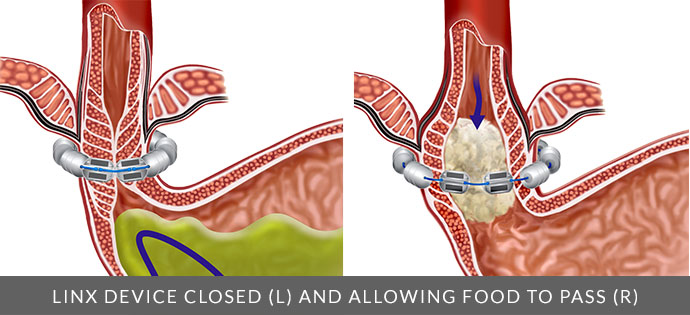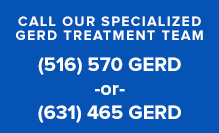LINX Device for GERD Treatment
One of the latest and most effective treatments for chronic acid reflux or GERD is a medical device known as LINX. This device is a small ‘bracelet’ composed of titanium beads with a magnetic clasp. The circumference of the device is similar to a quarter. The device is flexible and can expand or contract when necessary, which allows for movement of food and liquid downward while restricting the movement of acid upward.

The LINX procedure requires approximately 15 to 20 minutes of the operative time. Patients are placed under general anesthesia and a few tiny incisions are made in the abdomen through which specially made medical devices are passed. The device is wrapped around the Lower Esophageal Sphincter (LES) and the magnetic clasp is fixed in place. The added compression placed on the LES does not allow stomach acid to push back into the esophagus. However, food and liquid is allowed through the device due to its expandable nature. Once the foods has passed, the device contracts once again.
Hospital Stay and Recovery
Because of the simple nature of the procedure, it is commonly performed on an outpatient basis which means that patients can leave the hospital on the same day as the procedure. While patients will be sore for a few days after surgery there’re no specific restrictions on diet or exercise. Patients should, however, have someone assist them with returning home and they have surgery as well as housework for the first few days as pain medication begins to wear off.
Risks of the LINX Procedures
The LINX procedure has shown promise in the long-term improvement or resolution of the symptoms of chronic acid reflux. Of course, as with any surgical procedure there are inherent risks which can include pain, bleeding and infection. These risks will be covered during consultation and the postoperative packet will detail when a patient should call their surgeon. While rare, the main concern is of the device shifting or eroding into the esophagus, which would require its removal.
One of the biggest concerns of any procedure that constricts the lower esophageal sphincter is that patients will have a hard time burping or vomiting when necessary. While this is also a concern with the links device, the risks of this occurrence is lower than with a fundoplication.
Your Next Steps
 LINX is suitable for a wide range of patients experiencing mild to severe GERD. Even those with a somewhat higher surgical risk may benefit from the procedure. To learn more about the procedure and to see if it is an appropriate option for you, we encourage you to contact our office to schedule a consultation.
LINX is suitable for a wide range of patients experiencing mild to severe GERD. Even those with a somewhat higher surgical risk may benefit from the procedure. To learn more about the procedure and to see if it is an appropriate option for you, we encourage you to contact our office to schedule a consultation.
